SpringBoot学习(1)
内容概要:

spring data
springboot是spring团队基于spring4开发的一个框架。
springboot来简化spring应用开发,约定大于配置,去繁从简,just run就能创建一个独立的,产品级的应用。
springboot的优点
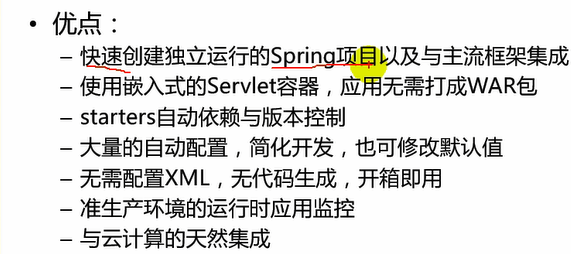
快速创建独立运行的spring项目以及与主流框架继承
starters自动依赖与版本控制
大量的自动配置,简化开发,也可修改默认值
无需配置XML,无代码生成,开箱即用(都是用一些自己写好的API配置好)
准生成环境的运行时应用监控
与云计算的天然集成
缺点:
入门容易,精通难。要对SpringBoot底层的API有一定的了解,才能真正掌握springboot。
springboot入门
1、springboot简介
简化spring应用开发的一个框架
整个spring技术栈的一个大整合
javaee开发的一站式解决方案;
2、微服务
2014年,martln fowler
微服务:架构风格
一个应用应该是一组小型服务;可以通过http的方式进行互通;
单体引用: all in one
每一个功能元素最终都是一个可独立替换和独立升级的软件单元
环境约束
–jdk1.8:Spring Boot 推荐jdk1.7及以上;java version "1.8.0_112"
–maven3.x:maven 3.3以上版本;Apache Maven 3.3.9
–IntelliJIDEA2017:IntelliJ IDEA 2017.2.2 x64、STS
–SpringBoot 1.5.9.RELEASE:1.5.9;
统一环境;
1、MEVEN设置;
给maven的settings.xml配置文件的profiles标签添加
将maven整合到idea中。
2、IDEA设置
4、Spring Boot HelloWorld
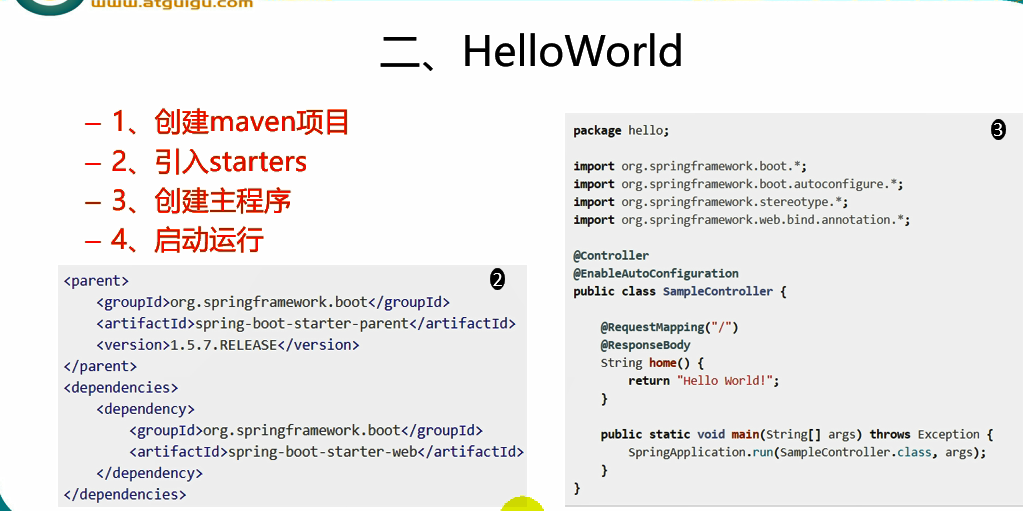
一个功能:
浏览器发送hello请求,服务器接受请求并处理,响应HelloWorld字符串
1、创建一个maven工程;(jar)
2、导入依赖springboot相关依赖
<parent> <groupId>org.springframework.boot</groupId> <artifactId>spring-boot-starter-parent</artifactId> <version>1.5.9.RELEASE</version> </parent> <dependencies> <dependency> <groupId>org.springframework.boot</groupId> <artifactId>spring-boot-starter-web</artifactId> </dependency> </dependencies>
3、编写一个主程序:
package com.atguigu; import org.springframework.boot.SpringApplication; import org.springframework.boot.autoconfigure.SpringBootApplication; /** * @SpringBootApplication来标注一个主程序块,说明这是一个SpringBoot应用 */ @SpringBootApplication public class HelloWorldMainApplication { public static void main(String[] args) { //Spring应用启动起来 SpringApplication.run(HelloWorldMainApplication.class,args); System.out.print("Spring Demo"); } }
4、编写相关的Controller、Service
package com.atguigu.controller; import org.springframework.stereotype.Controller; import org.springframework.web.bind.annotation.RequestMapping; import org.springframework.web.bind.annotation.ResponseBody; @Controller public class HelloController { @ResponseBody @RequestMapping("/hello") public String hello(){ return "Hello World!"; } }
5、运行主程序
6、简化部署
导入插件
<!-- 这个插件,可以将应用打包成一个可执行的jar包 --> <build> <plugins> <plugin> <groupId>org.springframework.boot</groupId> <artifactId>spring-boot-maven-plugin</artifactId> </plugin> </plugins> </build>
将这个应用打成jar包,直接使用java -jar的命令进行运行。
打包方式是
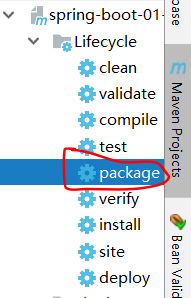
然后在target中找到该Jar,赋值到桌面,然后运行。
在cmd中直接进入桌面路径,然后使用命令java -jar 工程名.jar,回车就可以运行了。

运行成功如下所示:

在浏览器中直接输入http://localhost:8080/hello就可以访问了。
HelloWorld探究
1、POM文件
1、父项目
<parent> <groupId>org.springframework.boot</groupId> <artifactId>spring-boot-starter-parent</artifactId> <version>1.5.9.RELEASE</version> </parent>
它的父项目是
<parent>
<groupId>org.springframework.boot</groupId>
<artifactId>spring-boot-dependencies</artifactId>
<version>1.5.9.RELEASE</version>
<relativePath>../../spring-boot-dependencies</relativePath>
</parent>
它来真正管理springboot应用里面的所有依赖版本;
SpringBoot的版本仲裁中心;
以后我们导入依赖默认是不需要写版本;(没有在dependencies里面管理的依赖自然需要声明版本号)
2、启动器
<dependency> <groupId>org.springframework.boot</groupId> <artifactId>spring-boot-starter-web</artifactId> </dependency>
spring-boot-starter-web:
spring-boot-starter:spring-boot场景启动器;帮我们导入了web模块正常运行所依赖的组件;
SpringBoot将所有的功能场景都取出来,做成一个个的starters(启动器),只需要在项目里面引入这些starter相关场景的所有依赖都会导入进来。要用什么功能就导入什么场景的启动器。
2、主程序类,主入口类
/** * @SpringBootApplication来标注一个主程序块,说明这是一个SpringBoot应用 */ @SpringBootApplication public class HelloWorldMainApplication { public static void main(String[] args) { //Spring应用启动起来 SpringApplication.run(HelloWorldMainApplication.class,args); System.out.print("Spring Demo"); } }
@SpringBootApplication
Spring Boot应用标注在某个类上说明这个类是Spring Boot的主配置类,SpringBoot就应该运行这个类的main方法来启动SpringBoot应用;
@Target({ElementType.TYPE}) @Retention(RetentionPolicy.RUNTIME) @Documented @Inherited @SpringBootConfiguration @EnableAutoConfiguration @ComponentScan( excludeFilters = {@Filter( type = FilterType.CUSTOM, classes = {TypeExcludeFilter.class} ), @Filter( type = FilterType.CUSTOM, classes = {AutoConfigurationExcludeFilter.class} )} ) public @interface SpringBootApplication {
@SpringBootConfiguration:SpringBoot的配置类;
标注在某个类上,表示这是一个SpringBoot的配置类;
@Configuration:(它是spring定义的底层注解)
配置类上来标注这个注解;
配置类--配置文件;配置类也是容器中的一个组件;@Component
@EnableAutoConfiguration:开启自动配置功能;
以前我们需要配置的东西,SpringBoot帮我们自动配置;@EnableAutoConfiguration告诉
SpringBoot开启自动配置功能;这样自动配置才能生效
它也是一个组合注解
AutoConfigurationPackage @Import({EnableAutoConfigurationImportSelector.class}) public @interface EnableAutoConfiguration {
@AutoConfigurationPackage:自动配置包
@Import({Registrar.class});
Spring的底层注解@import,给容器中导入一个组件;导入的组件由AutoConfigurationPackage.Register.class
将主配置类(@SpringBootApplication标注的类)的所在包及下面所有子包里面的所有组件扫描到Spring容器;
@Import({EnableAutoConfigurationImportSelector.class})
给容器中导入组件
EnableAutoConfigurationImportSelector:导入哪些组件的选择器
将所有需要导入的组件以全类名的方式返回;这些组件就会被添加到容器中了。
会给容器中导入非常多的自动配置类(xxAutoConfiguration);就是给容器中导入这个场景需要的所有组件,并配置好这些组件;

有了自动配置类,就免去了我们手动编写配置注入功能组件等的工作;
SpringFactoriesLoader.loadFactoryNames(EnableAutoConfiguration.class);
SpringBoot在启动的时候从从类路径下的META-INF/spring.factories中获取EnableAutoConfiguration指定的值,将这些值作为自动配置的类导入到容器中,自动配置类就生效,帮我们进行自动配置工作;以前我们需要自己配置的东西,自动配置类都帮我们做了;
J2EE的整体整合解决方法和自动配置都在spring-boot-autoconfigure-1.5.9.RELEASE.jar;
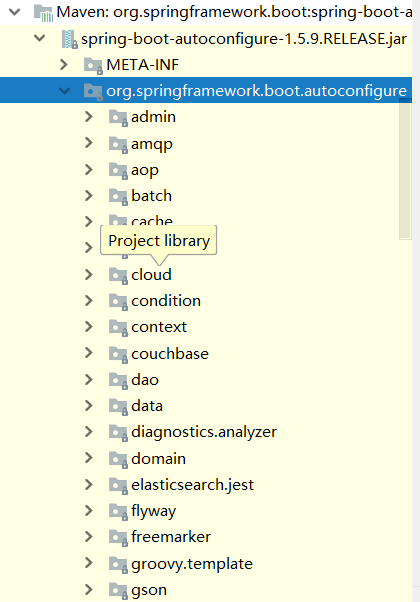
Spring注解版(谷粒学院)
6、使用Spring Initializer快速创建Spring Boot项目
IDE都支持使用Spring的项目创建向导快速创建一个SpringBoot项目;
选择我们需要的模块;向导会联网创建Spring Boot项目
默认生成的Spring Boot项目;
①主程序已经生成好了,我们只需要我们自己的逻辑
②resources文件中目录结构
static:保存所有的静态资源;js css images;
templates:保存所有的模板页面;(spring boot默认jar包使用嵌入式的Tomcat,默认不支持jsp页面);可以使用模板引擎(freemarker、thymeleaf);
application.properties:Spring Boot应用的配置文件;可以修改一些默认配置;
二、配置文件
1、配置文件
SpringBoot使用一个全局的配置文件,配置文件名是固定的;
application.properties
application.yml
配置文件的作用:修改SpringBoot自动配置的默认值;SpringBoot在底层都给我们自动配置好
YAML(YAML Ain't Markup Language)
YAML A Markup Language:是一个标记语言
YAML isn't Markup Language:不是一个标记语言;
标记语言:
以前的配置文件;大多都使用的是xxxx.xml文件
YAML:以数据为中心,比json、xml等更适合做配置文件;
YAML:配置例子
server:
port: 8080
XML:
<server> <port>8081</port> </server>
2、YAML语法:
1、基本语法
k:v:表示一对键值对(空格必须有);
以空格的缩进来控制层级关系;只要是左对齐的一列数据,都是同一层级的
server:
port: 8081
path: /hello
属性和值也是大小写敏感的;
2、值的写法
字面量:普通的值(数字,字符串,布尔)
k:v:字面直接来写;
字符串默认不用加上单引号或者双引号;
"":双引号;不会转义字符串里面的特殊字符;特殊字符会作为本身想表示的意思
name:"zhangsan \n lisi":输出;zhangsan 换行 lisi
":单引号;会转义特殊翼支付,特殊字符最终只是一个普通的字符串数据
name:'zhangsan \n lisi':输出;zhangsan \n lisi
对象、Map(属性和值)(键值对):
k:v:在下一行来写对象的属性和值的关系;注意缩进
对象还是k:v的方式
friends:
lastName:zhangsan
age:20
行内写法:
friends:{lastName:zhangsan,age:18}
数组(List、Set):
用-值表示数组中的一个元素
pets:
-cat
-dog
-pig
行内写法
pets:[cat,dog,pig]
3、配置文件值注入
配置文件
server:
port: 8081
person:
lastName: zhangsan
age: 18
boss: false
birth: 2017/12/12
maps: {k1: v1,k2: 12}
lists:
- lisi
- zhaoliu
dog:
name: 小狗
age: 2
javabean
/** * 将配置文件中的每一个属性的值,映射到这个组件中 * @ConfigurationProperties:告诉SpringBoot将本类中的所有属性和配置文件中相关配合进行绑定; * prefix="person":配置文件中哪个下面的所有属性进行一一映射 * 只有这个组件是容器中的组件,才能使用容器提供的@ConfigurationProperties功能; */ @Component @ConfigurationProperties(prefix="person") public class Person { private String lastName; private Integer age; private Boolean boss; private Date birth; private Map<String,Object> maps; private List<Object> lists; private Dog dog;
我们可以导入配置文件处理器,以后编写配置就有提示了
<dependency> <groupId>org.springframework.boot</groupId> <artifactId>spring-boot-configuration-processor</artifactId> <optional>true</optional> </dependency>
在yml中
last-name: zhangsan
和
lastName: zhangsan
是一样的。
properties进行设置的时候需要进行设置,设置过程如下所示:
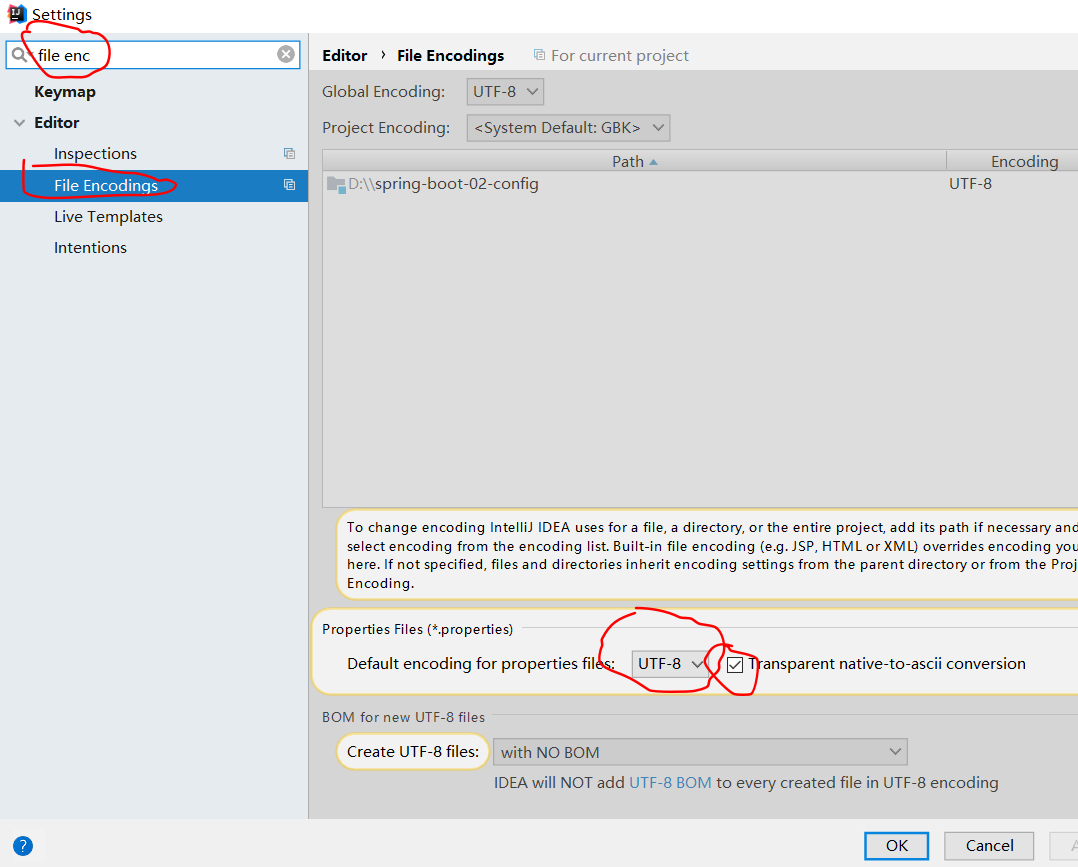
2、@Value获取值和@ConfigurationProperties获取值比较
前者是一个一个指定,后者是批量注入文件中的属性
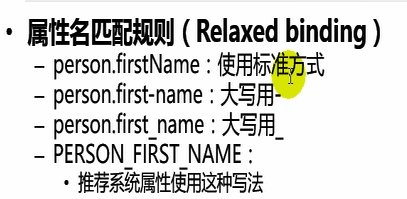
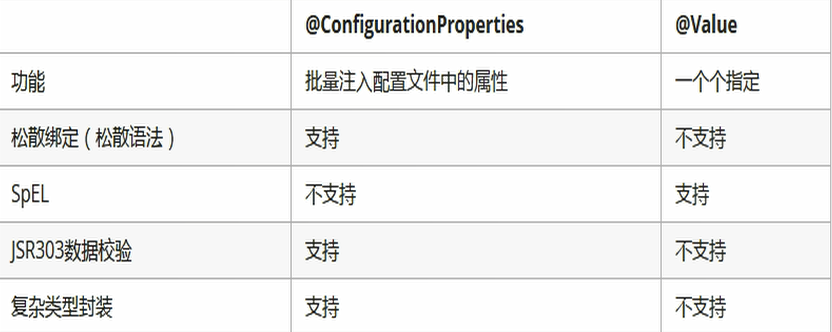
如果使用的是这样获取值方式
@Value("${person.last-name}")
那么jsr303验证将不会生效
配置文件yml还是properties它们都能获取值
@Value不支持复杂类型封装
如果说,我们只是在某个业务逻辑中需要获取一下配置文件中的某项值,使用@Value
3、配置文件注入值数据校验
@Component @ConfigurationProperties(prefix="person") @Validated public class Person { /** * <bean class="Person"> * <property name="lastName" value="字面量/${key}从环境变量、配置文件中获取值/#{sqEL}"></property> * </bean> */ //@Value("${person.last-name}") //如果写lastName会报错,不支持松散绑定 //lastName必须是邮箱格式 //@Email private String lastName; //@Value("#{11*2}") private Integer age;
如果说,我们专门编写了一个javaBean来和配置文件进行映射,我们就直接使用@ConfigurationProperties
4、@PropertySource&@ImportResource
@PropertySource:加载指定的配置文件;
/** * 将配置文件中的每一个属性的值,映射到这个组件中 * @ConfigurationProperties:告诉SpringBoot将本类中的所有属性和配置文件中相关配合进行绑定; * prefix="person":配置文件中哪个下面的所有属性进行一一映射 * 只有这个组件是容器中的组件,才能使用容器提供的@ConfigurationProperties功能; * @ConfigurationProperties(prefix="person")默认从全局配置文件中获取值; */ @PropertySource(value={"classpath:person.properties"}) @Component @ConfigurationProperties(prefix="person") //@Validated public class Person { /** * <bean class="Person"> * <property name="lastName" value="字面量/${key}从环境变量、配置文件中获取值/#{sqEL}"></property> * </bean> */ //@Value("${person.last-name}") //如果写lastName会报错,不支持松散绑定 //lastName必须是邮箱格式 //@Email private String lastName; //@Value("#{11*2}") private Integer age; //@Value("true") private Boolean boss;
@ImportResource:导入Spring的配置文件,让配置文件里面的内容生效;
Spring Boot里面没有Spring的配置文件,我们自己编写的配置文件,也不能自动识别;
想让Spring的配置文件生效,加载进来;@ImportResource标注在一个配置类上
@ImportResource(locations={"classpath:beans.xml"})
导入spring的配置文件让其生效
不来编写Spring的配置文件
<?xml version="1.0" encoding="UTF-8"?> <beans xmlns="http://www.springframework.org/schema/beans" xmlns:xsi="http://www.w3.org/2001/XMLSchema-instance" xsi:schemaLocation="http://www.springframework.org/schema/beans http://www.springframework.org/schema/beans/spring-beans.xsd"> <bean id="helloService" class="com.atguigu.springboot.service.HelloService"></bean> </beans>
SpringBoot推荐给容器中添加组件的方式;
1、配置类======SpringBoot配置文件
2、使用@Bean给容器中添加组件
/** * @Configuration:指明当前类是一个配置类;就是来替代之前的Spring配置文件 * * 在配置文件中用<bean></bean>标签添加组件 */ @Configuration public class MyAppConfig { //将方法的返回值添加到容器中;容器中这个组件默认的id就是方法名 @Bean public HelloService helloService(){ System.out.println("配置类@Bean给容器中添加组件了..."); return new HelloService(); } }
4、配置文件占位符
1、随机数
2、占位符获取之前配置的值,如果没有可以使用:指定默认值
person.last-name=张三${random.uuid}
person.age=${random.int}
person.birth=2017/12/15
person.boss=false
person.maps.k1=v1
person.maps.k2=14
person.lists=a,b,c
person.dog.name=${person.hello:hello}_dog
person.dog.age=15
5、Profile
1、多Profile文件
我们在主配置文件编写的时候,文件名可以是application-{profile}.properties/yml
默认使用application.properties的配置;
2、yml支持多文档块方式
server:
port: 8081
spring:
profiles:
active: prod
---
server:
port: 8083
spring:
profiles: dev
---
server:
port: 8084
spring:
profiles: prod #指定属于哪个环境
3、激活指定profile
1、在配置文件中指定spring.profiles.active=dev
2、命令行:
java -jar spring-boot-02-config-0.0.1-SNAPSHOT.jar --spring.profiles.active=dev
可以直接在测试的时候,配置传入命令行的参数
3、虚拟机参数;
-Dspring.profiles.active=dev
6、配置文件加载位置
springboot启动会扫描以下位置的application.properties或者application.yml文件作为springboot的默认配置文件
-file:./config/
-file:./
-classpath:/config/
-classpath:/
优先级由高到低,高优先级的配置会覆盖低优先级的配置;
springboot会从这四个位置全部加载主配置文件;互补配置;
我们还可以通过spring.config.location来改变默认的配置文件位置
项目打包以后,我们可以使用命令行参数的形式,启动项目的时候来指定配置文件的新位置;指定配置文件和默认加载的这些配置文件共同起作用形成互补配置;
在测试的时候可以使用代码
java -jar spring-boot-02-config-02-0.0.1-SNAPSHOT.jar --spring.co
nfig.location=D:/application.properties
其中application.properties文件中指明端口号。
7、外部配置加载顺序
springboot也可以从以下位置加载配置;优先级从高到低;高优先级的配置覆盖低优先级的配置,所有的配置会形成互补的配置
1.命令行参数
所有的配置都可以在命令行上进行指定
java -jar spring-boot-02-config-02-0.0.1-SNAPSHOT.jar --server.port=8087 --server.context-path=/abc
多个配置用空格分开;--配置项=值
2.来自java:comp/env的JNDI属性
3.Java系统属性(System.getProperties())
4.操作系统环境变量
5.RandomValuePropertySource配置的random.*属性值
由jar包外向jar包内进行寻找;
由jar包向jar包内进行寻找
优先加载带profile
6.jar包外部的application-{profile}.properties或application.yml(带spring.profile)配置文件
7.jar包内部的application-{profile}.properties或application.yml(带spring.profile)配置文件
再来加载不带profile
8.jar包外部的application.properties或application.yml(不带spring.profile)配置文件
9.jar包内部的application.properties或application.yml(不带spring.profile)配置文件
10.@Configuration注解类上的@PropertySource
11.通过SpringApplication.setDefaultProperties指定的默认属性
所有配置加载来源;
参考官方文档
8、自动配置原理
配置文件到底能写什么?怎么写?自动配置原理;
自动配置原理
1)、SpringBoot启动的时候加载主配置类,开启了自动配置功能@EnableAutoConfiguration
2)、@EnableAutoConfiguration作用:
①利用EnableAutoConfigurationImportSelector给容器中导入一些组件?
②可以查看selectImports()方法的内容;
③List<String> configurations = getCandidateConfigurations(annotationMetadata,attributes);获取候选的配置
SpringFactoriesLoader.loadFactoryNames()
扫描所有jar包类路径下的 META-INF/spring.factories
把扫描到的这些文件的内容包装成properties对象
从properties中获取到EnableAutoConfiguration.class类(类名)对应的值,然后把他们添加在容器中
将类路径下 META-INF/spring.factories里面配置的所有EnableAutoConfiguration的值加入到了容器中;
# Auto Configure
org.springframework.boot.autoconfigure.EnableAutoConfiguration=\
org.springframework.boot.autoconfigure.admin.SpringApplicationAdminJmxAutoConfiguration,\
org.springframework.boot.autoconfigure.aop.AopAutoConfiguration,\
org.springframework.boot.autoconfigure.amqp.RabbitAutoConfiguration,\
org.springframework.boot.autoconfigure.batch.BatchAutoConfiguration,\
org.springframework.boot.autoconfigure.cache.CacheAutoConfiguration,\
org.springframework.boot.autoconfigure.cassandra.CassandraAutoConfiguration,\
org.springframework.boot.autoconfigure.cloud.CloudServiceConnectorsAutoConfiguration,\
org.springframework.boot.autoconfigure.context.ConfigurationPropertiesAutoConfiguration,\
org.springframework.boot.autoconfigure.context.MessageSourceAutoConfiguration,\
org.springframework.boot.autoconfigure.context.PropertyPlaceholderAutoConfiguration,\
org.springframework.boot.autoconfigure.couchbase.CouchbaseAutoConfiguration,\
org.springframework.boot.autoconfigure.dao.PersistenceExceptionTranslationAutoConfiguration,\
org.springframework.boot.autoconfigure.data.cassandra.CassandraDataAutoConfiguration,\
org.springframework.boot.autoconfigure.data.cassandra.CassandraReactiveDataAutoConfiguration,\
org.springframework.boot.autoconfigure.data.cassandra.CassandraReactiveRepositoriesAutoConfiguration,\
org.springframework.boot.autoconfigure.data.cassandra.CassandraRepositoriesAutoConfiguration,\
org.springframework.boot.autoconfigure.data.couchbase.CouchbaseDataAutoConfiguration,\
org.springframework.boot.autoconfigure.data.couchbase.CouchbaseReactiveDataAutoConfiguration,\
org.springframework.boot.autoconfigure.data.couchbase.CouchbaseReactiveRepositoriesAutoConfiguration,\
org.springframework.boot.autoconfigure.data.couchbase.CouchbaseRepositoriesAutoConfiguration,\
org.springframework.boot.autoconfigure.data.elasticsearch.ElasticsearchAutoConfiguration,\
org.springframework.boot.autoconfigure.data.elasticsearch.ElasticsearchDataAutoConfiguration,\
org.springframework.boot.autoconfigure.data.elasticsearch.ElasticsearchRepositoriesAutoConfiguration,\
org.springframework.boot.autoconfigure.data.jdbc.JdbcRepositoriesAutoConfiguration,\
org.springframework.boot.autoconfigure.data.jpa.JpaRepositoriesAutoConfiguration,\
org.springframework.boot.autoconfigure.data.ldap.LdapRepositoriesAutoConfiguration,\
org.springframework.boot.autoconfigure.data.mongo.MongoDataAutoConfiguration,\
org.springframework.boot.autoconfigure.data.mongo.MongoReactiveDataAutoConfiguration,\
org.springframework.boot.autoconfigure.data.mongo.MongoReactiveRepositoriesAutoConfiguration,\
org.springframework.boot.autoconfigure.data.mongo.MongoRepositoriesAutoConfiguration,\
org.springframework.boot.autoconfigure.data.neo4j.Neo4jDataAutoConfiguration,\
org.springframework.boot.autoconfigure.data.neo4j.Neo4jRepositoriesAutoConfiguration,\
org.springframework.boot.autoconfigure.data.solr.SolrRepositoriesAutoConfiguration,\
org.springframework.boot.autoconfigure.data.redis.RedisAutoConfiguration,\
org.springframework.boot.autoconfigure.data.redis.RedisReactiveAutoConfiguration,\
org.springframework.boot.autoconfigure.data.redis.RedisRepositoriesAutoConfiguration,\
org.springframework.boot.autoconfigure.data.rest.RepositoryRestMvcAutoConfiguration,\
org.springframework.boot.autoconfigure.data.web.SpringDataWebAutoConfiguration,\
org.springframework.boot.autoconfigure.elasticsearch.jest.JestAutoConfiguration,\
org.springframework.boot.autoconfigure.elasticsearch.rest.RestClientAutoConfiguration,\
org.springframework.boot.autoconfigure.flyway.FlywayAutoConfiguration,\
org.springframework.boot.autoconfigure.freemarker.FreeMarkerAutoConfiguration,\
org.springframework.boot.autoconfigure.gson.GsonAutoConfiguration,\
org.springframework.boot.autoconfigure.h2.H2ConsoleAutoConfiguration,\
org.springframework.boot.autoconfigure.hateoas.HypermediaAutoConfiguration,\
org.springframework.boot.autoconfigure.hazelcast.HazelcastAutoConfiguration,\
org.springframework.boot.autoconfigure.hazelcast.HazelcastJpaDependencyAutoConfiguration,\
org.springframework.boot.autoconfigure.http.HttpMessageConvertersAutoConfiguration,\
org.springframework.boot.autoconfigure.http.codec.CodecsAutoConfiguration,\
org.springframework.boot.autoconfigure.influx.InfluxDbAutoConfiguration,\
org.springframework.boot.autoconfigure.info.ProjectInfoAutoConfiguration,\
org.springframework.boot.autoconfigure.integration.IntegrationAutoConfiguration,\
org.springframework.boot.autoconfigure.jackson.JacksonAutoConfiguration,\
org.springframework.boot.autoconfigure.jdbc.DataSourceAutoConfiguration,\
org.springframework.boot.autoconfigure.jdbc.JdbcTemplateAutoConfiguration,\
org.springframework.boot.autoconfigure.jdbc.JndiDataSourceAutoConfiguration,\
org.springframework.boot.autoconfigure.jdbc.XADataSourceAutoConfiguration,\
org.springframework.boot.autoconfigure.jdbc.DataSourceTransactionManagerAutoConfiguration,\
org.springframework.boot.autoconfigure.jms.JmsAutoConfiguration,\
org.springframework.boot.autoconfigure.jmx.JmxAutoConfiguration,\
org.springframework.boot.autoconfigure.jms.JndiConnectionFactoryAutoConfiguration,\
org.springframework.boot.autoconfigure.jms.activemq.ActiveMQAutoConfiguration,\
org.springframework.boot.autoconfigure.jms.artemis.ArtemisAutoConfiguration,\
org.springframework.boot.autoconfigure.groovy.template.GroovyTemplateAutoConfiguration,\
org.springframework.boot.autoconfigure.jersey.JerseyAutoConfiguration,\
org.springframework.boot.autoconfigure.jooq.JooqAutoConfiguration,\
org.springframework.boot.autoconfigure.jsonb.JsonbAutoConfiguration,\
org.springframework.boot.autoconfigure.kafka.KafkaAutoConfiguration,\
org.springframework.boot.autoconfigure.ldap.embedded.EmbeddedLdapAutoConfiguration,\
org.springframework.boot.autoconfigure.ldap.LdapAutoConfiguration,\
org.springframework.boot.autoconfigure.liquibase.LiquibaseAutoConfiguration,\
org.springframework.boot.autoconfigure.mail.MailSenderAutoConfiguration,\
org.springframework.boot.autoconfigure.mail.MailSenderValidatorAutoConfiguration,\
org.springframework.boot.autoconfigure.mongo.embedded.EmbeddedMongoAutoConfiguration,\
org.springframework.boot.autoconfigure.mongo.MongoAutoConfiguration,\
org.springframework.boot.autoconfigure.mongo.MongoReactiveAutoConfiguration,\
org.springframework.boot.autoconfigure.mustache.MustacheAutoConfiguration,\
org.springframework.boot.autoconfigure.orm.jpa.HibernateJpaAutoConfiguration,\
org.springframework.boot.autoconfigure.quartz.QuartzAutoConfiguration,\
org.springframework.boot.autoconfigure.reactor.core.ReactorCoreAutoConfiguration,\
org.springframework.boot.autoconfigure.security.servlet.SecurityAutoConfiguration,\
org.springframework.boot.autoconfigure.security.servlet.SecurityRequestMatcherProviderAutoConfiguration,\
org.springframework.boot.autoconfigure.security.servlet.UserDetailsServiceAutoConfiguration,\
org.springframework.boot.autoconfigure.security.servlet.SecurityFilterAutoConfiguration,\
org.springframework.boot.autoconfigure.security.reactive.ReactiveSecurityAutoConfiguration,\
org.springframework.boot.autoconfigure.security.reactive.ReactiveUserDetailsServiceAutoConfiguration,\
org.springframework.boot.autoconfigure.sendgrid.SendGridAutoConfiguration,\
org.springframework.boot.autoconfigure.session.SessionAutoConfiguration,\
org.springframework.boot.autoconfigure.security.oauth2.client.servlet.OAuth2ClientAutoConfiguration,\
org.springframework.boot.autoconfigure.security.oauth2.client.reactive.ReactiveOAuth2ClientAutoConfiguration,\
org.springframework.boot.autoconfigure.security.oauth2.resource.servlet.OAuth2ResourceServerAutoConfiguration,\
org.springframework.boot.autoconfigure.security.oauth2.resource.reactive.ReactiveOAuth2ResourceServerAutoConfiguration,\
org.springframework.boot.autoconfigure.solr.SolrAutoConfiguration,\
org.springframework.boot.autoconfigure.task.TaskExecutionAutoConfiguration,\
org.springframework.boot.autoconfigure.task.TaskSchedulingAutoConfiguration,\
org.springframework.boot.autoconfigure.thymeleaf.ThymeleafAutoConfiguration,\
org.springframework.boot.autoconfigure.transaction.TransactionAutoConfiguration,\
org.springframework.boot.autoconfigure.transaction.jta.JtaAutoConfiguration,\
org.springframework.boot.autoconfigure.validation.ValidationAutoConfiguration,\
org.springframework.boot.autoconfigure.web.client.RestTemplateAutoConfiguration,\
org.springframework.boot.autoconfigure.web.embedded.EmbeddedWebServerFactoryCustomizerAutoConfiguration,\
org.springframework.boot.autoconfigure.web.reactive.HttpHandlerAutoConfiguration,\
org.springframework.boot.autoconfigure.web.reactive.ReactiveWebServerFactoryAutoConfiguration,\
org.springframework.boot.autoconfigure.web.reactive.WebFluxAutoConfiguration,\
org.springframework.boot.autoconfigure.web.reactive.error.ErrorWebFluxAutoConfiguration,\
org.springframework.boot.autoconfigure.web.reactive.function.client.ClientHttpConnectorAutoConfiguration,\
org.springframework.boot.autoconfigure.web.reactive.function.client.WebClientAutoConfiguration,\
org.springframework.boot.autoconfigure.web.servlet.DispatcherServletAutoConfiguration,\
org.springframework.boot.autoconfigure.web.servlet.ServletWebServerFactoryAutoConfiguration,\
org.springframework.boot.autoconfigure.web.servlet.error.ErrorMvcAutoConfiguration,\
org.springframework.boot.autoconfigure.web.servlet.HttpEncodingAutoConfiguration,\
org.springframework.boot.autoconfigure.web.servlet.MultipartAutoConfiguration,\
org.springframework.boot.autoconfigure.web.servlet.WebMvcAutoConfiguration,\
org.springframework.boot.autoconfigure.websocket.reactive.WebSocketReactiveAutoConfiguration,\
org.springframework.boot.autoconfigure.websocket.servlet.WebSocketServletAutoConfiguration,\
org.springframework.boot.autoconfigure.websocket.servlet.WebSocketMessagingAutoConfiguration,\
org.springframework.boot.autoconfigure.webservices.WebServicesAutoConfiguration,\
org.springframework.boot.autoconfigure.webservices.client.WebServiceTemplateAutoConfiguration
每一个这样的xxxAutoConfiguration类都是容器中的一个组件,都加入到容器中;用他们来做自动配置;
3)、每一个自动类进行自动配置功能;
4)、以HttpEncodingAutoConfiguration(Http编码自动配置)为例解释自动配置原理;
@Configuration//表示这是一个配置类,以前编写的配置文件一样,也可以给容器中添加组件 @EnableConfigurationProperties({HttpProperties.class})//启动指定类的
ConfigurationProperties功能;将配置文件中对应的值和HttpEncodingProperties绑定起来; @ConditionalOnWebApplication(//Spring底层@Conditional注解,根据不同的条件,如果
满足指定的条件,
判断当前应用是否是web应用,如果是,当前配置类生效 type = Type.SERVLET ) @ConditionalOnClass({CharacterEncodingFilter.class})//判断当前项目有没有
这个类(CharacterEncodingFilter) ;SpringMVC中进行乱码解决的过滤器;
@ConditionalOnProperty( prefix = "spring.http.encoding",
value = {"enabled"}, matchIfMissing = true ) //判断配置文件中是否存在
某个配置spring.http.encoding.enabled;如果不存在,判断也成立的
//即使我们配置文件中不配置spring.http.encoding.enabled=true,也是默认生效的;
public class HttpEncodingAutoConfiguration {
//它已经和springboot的配置文件映射了
private final Encoding properties;
//只有一个有参构造器的情况下,参数的值就会从容器中拿
@Bean//给容器中添加一个组件,这个组件的某些值需要从properties中获取
@ConditionalOnMissingBean
public CharacterEncodingFilter characterEncodingFilter() {
CharacterEncodingFilter filter = new OrderedCharacterEncodingFilter();
filter.setEncoding(this.properties.getCharset().name());
filter.setForceRequestEncoding(this.properties.shouldForce(org.springframework.boot.autoconfigure.http.HttpProperties.Encoding.Type.REQUEST));
filter.setForceResponseEncoding(this.properties.shouldForce(org.springframework.boot.autoconfigure.http.HttpProperties.Encoding.Type.RESPONSE));
return filter;
}
根据当前不同的条件判断,决定这个配置类是否生效?
一旦这个配置类生效;这个配置类就会给容器中添加各种组件;这些组件的属性是从对应的properties类中获取的,这些类里面的每一个属性又是和配置文件绑定的;
5)、所有在配置文件中能配置的属性都是在xxxProperties类中封装着;配置文件能配置什么就可以参照某个功能对应的这个属性类
springboot精髓:
1)、springboot启动会加载大量的自动配置类
2)、我们看我们需要的功能有没有springboot默认写好的自动配置类;
3)、我们再来看这个自动配置类中到底配置了哪些组件;(只要我们要用的组件有,我们就不需要再来配置了)
4)、给容器中自动配置类添加组件的时候,会从properties类中获取牟星属性。我们就可以在配置文件中指定这些属性的值;
xxxAutoConfiguration:自动配置类;
给容器中添加组件
xxxProperties:封装配置文件中的相关属性;
2、细节
1、@Conditional派生注解(spring注解版原生的@Conditional作用)
作用:必须是@Conditional指定的条件成立,才给容器中添加组件,配置里面的内容才生效;
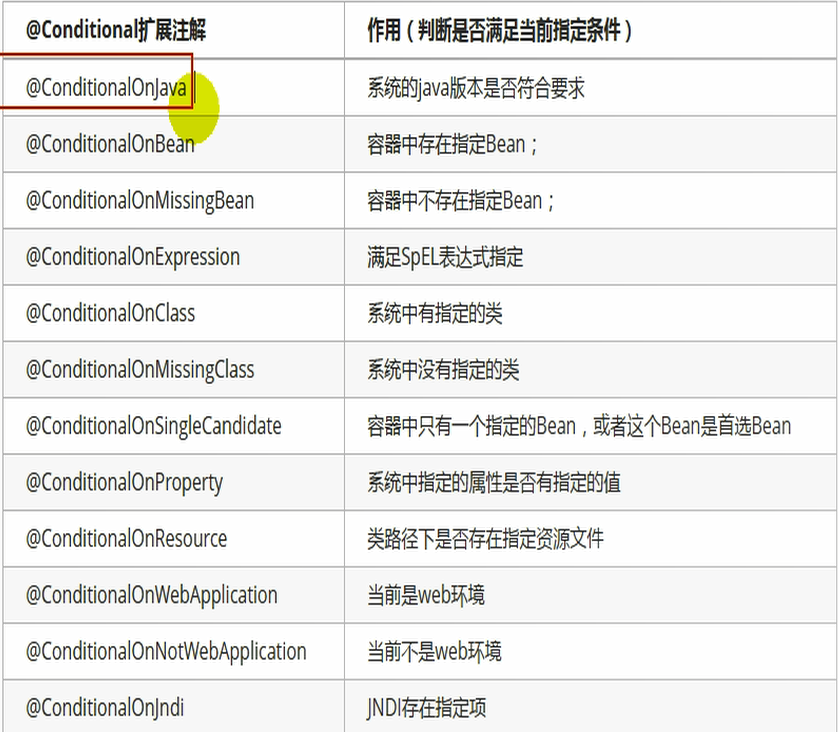
自动配置类必须在一定的条件下才能生效;
我们怎么知道哪些配置类自动生效;
我们可以启用debug=true属性(在application.properties中);来让控制台打印自动配置报告,这样我们就可以很方便地知道哪些自动配置类生效;
============================
CONDITIONS EVALUATION REPORT
============================
Positive matches:(自动配置类启用的)
-----------------
CodecsAutoConfiguration matched:
- @ConditionalOnClass found required class 'org.springframework.http.codec.CodecConfigurer' (OnClassCondition)
CodecsAutoConfiguration.JacksonCodecConfiguration matched:
- @ConditionalOnClass found required class 'com.fasterxml.jackson.databind.ObjectMapper' (OnClassCondition)
Negative matches:(没有启动,没有匹配成功的自动配置类)
-----------------
ActiveMQAutoConfiguration:
Did not match:
- @ConditionalOnClass did not find required class 'javax.jms.ConnectionFactory' (OnClassCondition)
AopAutoConfiguration:
Did not match:
- @ConditionalOnClass did not find required class 'org.aspectj.lang.annotation.Aspect' (OnClassCondition)




